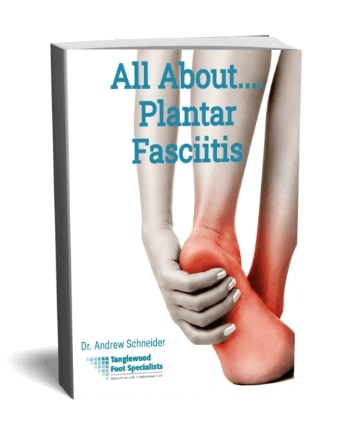 We see lots of patients who have plantar fasciitis. In fact, it's one of the most common complaints sending patients into our Houston podiatry practice. Basically, this is a condition that affects your plantar fascia. (That's a long, connective band of tissue in your foot.) With plantar fasciitis, the band becomes inflamed, causing you to experience heel pain. And that heel pain usually follows a pretty familiar pattern.
We see lots of patients who have plantar fasciitis. In fact, it's one of the most common complaints sending patients into our Houston podiatry practice. Basically, this is a condition that affects your plantar fascia. (That's a long, connective band of tissue in your foot.) With plantar fasciitis, the band becomes inflamed, causing you to experience heel pain. And that heel pain usually follows a pretty familiar pattern.
Plantar Fasciitis: Heel Pain and Other Symptoms
As we said, plantar fasciitis causes heel pain. At first, the heel pain isn't constant. Instead, it's usually worst when you wake up in the morning. Right after you get out of bed.
In the early stages, the pain usually improves throughout your day. But, without treatment? The heel pain will go from intermittent to chronic. And that's when you'll really need some help.
Now, a side note on symptoms. Most people experience pain in their heels with plantar fasciitis. But some people also develop arch pain. So if you notice sharp discomfort in your foot arch, you may also want to try the heel pain relief exercises we're about to suggest. And you'll want to follow our guidelines on exercise, if you don't want your problems getting worse.
Heel Pain Relief Exercises: Can They Help Plantar Fasciitis?
This condition is a common problem for runners. And as we all know, runners need to run. It's also a common concern for dancers, especially when they change from pointe shoes to flats. So it's not surprising that many of our heel pain patients share one big concern. When can I work out again?
Well, guess what: you don’t have to stop exercising while you recover from plantar fasciitis. You just have to follow our rehab suggestions, including stretches for heel pain. Then, switch up your exercise routine to not aggravate your plantar fascia.
Sounds complicated? It's actually pretty simple. But if you're now sure what to do, one great place to start that new routine is in the pool!
Water Workouts are the Perfect Place for Heel Pain Relief Exercises
Swimming is a great activity when you have plantar fasciitis. And that’s because of how this condition typically gets started: as an overuse injury. Most often, you irritate your plantar fascia by overdoing it on load-bearing activities like long runs. That's because training in the exact same way hits all the same muscles, never giving them a chance to rest and recover. (We can prevent this with rest days and cross training, by the way.)
For many of our patients, the problems don't stop there. You can make things worse for yourself if you choose un-supportive footwear. Or if you spend your downtime going barefoot. Then, if you add in biomechanical issues like tight or weak calf muscles? You're in for a world of heel pain.
Still, you want to stay active while you recover. And load-bearing exercise will likely increase your heel pain. So, what's the answer! Take it from us: swimming will solve so many of those problems.
First of all, it gets you into the water: a zero-impact environment. Right away, that takes all pressure off your plantar fascia, allowing it to heal even as you get in your cardio.
Second, the sport is designed to strengthen your leg muscles. That way, when you get back to land training? They can pull more of your weight and take a load off your feet and fascia. Better yet? You can choose strokes like the front crawl or freestyle. They emphasize leg propulsion and are great for building strength that will protect you in the future.
Want to take that strengthening up a notch? As long as you talk to me about this first, you can try wearing flippers while you swim laps. This will work as a great heel exercise for your recovery. The move will up the resistance on your legs and help you build larger muscles at a faster pace.
Of course, that’s your ultimate goal during your heel pain recovery period. Once your calf and leg muscles get stronger, it will help you gain more stability in your lower leg and ankle. That will remove a lot of stress from your plantar fascia, which will help it heal at a faster rate. And if this alone isn't enough? We can also fit you for custom orthotics, to help balance out faulty biomechanics.
How to Swim Safely With Plantar Fasciitis ![heel exercise runner in pool]()
Now, we did just say that water-based workouts take pressure off your lower body. But you still need to be careful when you try any type of workout while you’re in recovery.
Depending on how far your heel pain has progressed, you may find it painful to kick your legs. If that’s the case, try swimming with a floatation device, and avoid pushing off the wall when you start your laps. You can also introduce non-lap based workouts into your swimming routine. Try walking up and down a swim lane to get used to bearing a load on your feet—just do so in water deep enough that the process doesn’t hurt your feet.
You can try walking or even lightly jogging up and down the lanes for up to 20 minutes each session. Once your feet get comfortable in deep water, try moving to shallower depths, so your body gradually adjusts to carrying more of your own body weight. If your pain doesn’t get worse, you can work up to longer or more frequent weight-bearing sessions. Just be sure to listen to your body, and cut back or stop entirely if you experience pain during a workout, or if your heel pain seems worse after you get out of the pool.
Just remember: when you’re recovering from any foot condition, especially plantar fasciitis, getting better should be your primary goal. It’s not the time to worry about upping your fitness level. Still, staying active and building leg strength can help your recovery, so talk to Houston podiatrist Dr. Andrew Schneider about water workouts or other exercise programs that can help you recover from heel pain.






















